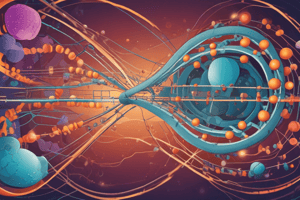Podcast
Questions and Answers
What is the translation process of proteins?
What is the translation process of proteins?
DNA → RNA → Polypeptide
What are the four levels of protein structure?
What are the four levels of protein structure?
Primary, Secondary, Tertiary, Quaternary
What structure do all amino acids share?
What structure do all amino acids share?
- Complex tertiary structure
- C-terminus (correct)
- N-terminus (correct)
- Simple backbone (correct)
What is meant by the genetic code being 'degenerate'?
What is meant by the genetic code being 'degenerate'?
What is the wobble position in a codon?
What is the wobble position in a codon?
What is an open reading frame (ORF)?
What is an open reading frame (ORF)?
Which types of mutations can occur in a coding sequence?
Which types of mutations can occur in a coding sequence?
How does the timing of translation differ between bacteria and eukaryotes?
How does the timing of translation differ between bacteria and eukaryotes?
The genetic code is universal across all organisms.
The genetic code is universal across all organisms.
What is required for the initiation of translation?
What is required for the initiation of translation?
What types of mutations can result from a single base change in the coding sequence?
What types of mutations can result from a single base change in the coding sequence?
Flashcards are hidden until you start studying
Study Notes
Protein Translation Overview
- The central dogma of molecular biology: DNA → RNA → Polypeptide.
- Amino acids have a simple backbone structure consisting of an amino group, a carboxyl group, and a side chain (R group).
- Four levels of protein structure: primary, secondary, tertiary, and quaternary.
Protein Structure
- Primary Structure: Sequence of amino acids in a polypeptide chain.
- Secondary Structure: Local folding of the polypeptide into alpha helices and beta sheets through hydrogen bonding.
- Tertiary Structure: Overall 3D shape formed by interactions among side chains (R groups).
- Quaternary Structure: Assembly of multiple polypeptide chains into a functional complex.
Genetic Code
- Codon: A sequence of three nucleotides in mRNA that specifies an amino acid.
- Degenerate: Multiple codons can code for the same amino acid.
- Universal: Genetic code is conserved across all forms of life, indicating common ancestry.
- Importance of a three-letter code allows for 64 possible combinations, far exceeding the number of amino acids.
Translation Process
- Initiation requires large and small ribosomal subunits, mRNA, tRNA (transfer RNA) with amino acids, and initiation factors.
- mRNA is read in triplets (codons), ensuring a non-overlapping reading frame.
- Reading Frame: The way nucleotides are grouped into codons; shifting it alters the entire sequence.
tRNA Role
- Each amino acid is linked to a specific tRNA, forming a "charged" tRNA.
- tRNA pairs with the mRNA codon, facilitating the translation of nucleic acid to amino acid.
Cellular Translation Differences
- Bacteria lack a nucleus, allowing transcription and translation to occur simultaneously.
- Eukaryotic translation requires processing of mRNA (e.g., capping and polyadenylation) before it can be translated.
Mutation Impact on Proteins
- Missense Mutation: Changes one amino acid, potentially altering protein function.
- Nonsense Mutation: Creates a premature stop codon, truncating the protein.
- Silent Mutation: Changes a nucleotide without affecting the amino acid sequence.
- Frameshift Mutation: Addition or deletion of nucleotides shifts the reading frame, impacting all downstream codons.
Summary of Mutational Effects
- Single base changes can result in various mutation types, affecting protein products significantly.
- Mutations may occur in coding or non-coding sequences, affecting gene regulation and expression.
- Mutations in somatic cells affect individual organisms; those in germ cells can be inherited.
Molecular Genetics Overview
- DNA identified as hereditary material through key experiments.
- Bacteria reproduce asexually but can exchange DNA through various mechanisms.
- DNA and RNA structure features (complementary bases, antiparallel strands) are crucial for understanding replication and transcription.
- The semiconservative model best explains DNA replication.
- Modifications to RNA transcripts are common before they become functional.
- Translation involves key roles for tRNA and rRNA to synthesize polypeptides from mRNA.
Studying That Suits You
Use AI to generate personalized quizzes and flashcards to suit your learning preferences.




